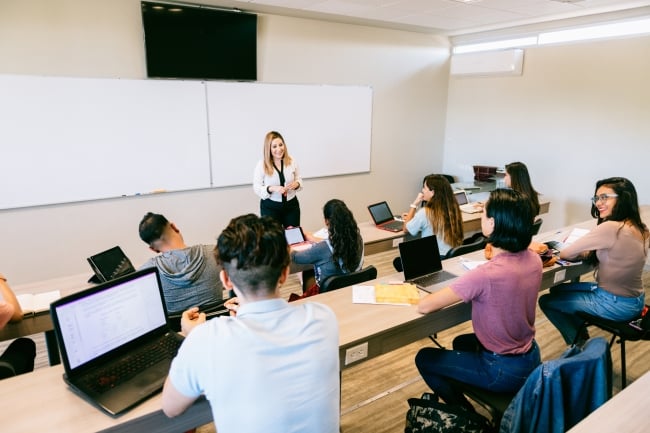You have /5 articles left.
Sign up for a free account or log in.

ferrantraite/E+/Getty Images
Rarely a week passes now without the publication of a new finding or statistic regarding the negative impact of the COVID-19 pandemic on student learning and overall well-being. While the initial shelter-at-home orders that precipitated remote learning were issued well over three years ago, their ripple effects still reverberate, and faculty members across the nation—including those at highly selective institutions—report that student disconnection and deficits in academic preparedness are as noticeable as ever.
Referrals to student support services and counseling centers are at an all-time high, and on some campuses, those offices are unable to meet student demand. As a result, campus leaders find themselves searching for other, more scalable solutions to address this widespread problem.
Certainly, the more acute post-pandemic struggles that interfere with our students’ learning—such as grief from the loss of a loved one or other pandemic-related trauma—are most appropriately dealt with through mental health counseling. But other, less grave struggles that aren’t as likely to warrant a referral to the counseling center—lack of motivation to complete assignments, disengagement in the classroom, difficulties in meeting deadlines—have now by default fallen in the laps of faculty members to resolve.
Some faculty members have admirably taken up the mantle and employed new approaches to engage students and foster connection within the classroom. But others find themselves in unfamiliar territory and are uncomfortable with the sometimes messy and unpredictable nature of classroom activities that address the social and emotional aspects of learning. As a colleague from another institution recently expressed to me, “I was trained as a cell biologist, not a social worker. I am not prepared for this.”
The discomfort that some faculty members feel with addressing the affective domain of learning in their classrooms is largely a reflection of our training in the academy. Overwhelmingly, we were educated to teach to cognitive outcomes. As a result, when developing our course syllabi, we design learning objectives and assignments that focus almost exclusively on students’ mastery of increasingly sophisticated cognitive tasks (remembering, understanding, applying, analyzing, evaluating and creating, as first described by Benjamin Bloom and his committee in 1956 and later revised by David R. Krathwohl). Few of us were trained to address feelings, attitudes or values in our classrooms unless they are explicitly a part of course content. And even if we include affective outcomes in our course designs, they aren’t purposefully taught or evaluated.
The irony of our historic neglect of the affective domain of learning is that it hampers our students’ mastery of the type of learning that the academy has traditionally prized: cognitive learning. Seldom is cognition not accompanied by some emotion, and in fact, it is our emotion that often motivates us to learn in the first place. How students feel about their learning is actually the gateway to their learning.
Bloom’s committee realized that at the time they developed their famous taxonomy for the cognitive domain of learning. Stating that affective domain is “the ‘box’ in which the most influential controls [for student learning] are to be found,” Krathwohl, Bloom and Bertram B. Masia developed an entirely separate taxonomy (receiving/attending, responding, valuing, organizing and characterizing) for educational goals related to the affective domain of learning.
According to the committee, “The affective domain contains the forces that determine the nature of an individual’s life and ultimately the life of an entire people. To keep the ‘box’ closed is to deny the existence of the powerful motivational forces that shape the life of each of us … Education is not the rote memorization of meaningless material to be regurgitated on an examination paper.”
Now more than ever, our students need us to open the box and tap into the affective domain of learning within our classrooms. Employing strategies that address the social and emotional aspects of learning will help us begin to deal with the widespread emotional hangover of the pandemic that is a significant barrier to our students’ engagement in the classroom and hence their academic progress.
Lest some faculty bristle at the thought of serving as social workers or armchair psychologists in the classroom, rest assured that this is not what I am suggesting. Plenty of evidence-based strategies are described in the teaching and learning literature that allow us to effectively address affective outcomes while still maintaining professionalism in the student-instructor relationship and remaining within our realm of professional expertise. By using simple strategies that enhance social connections in the classroom, that elicit positive feelings or personal connections with course content and the instructor, or that minimize stereotype threat, we can begin to chip away at the lack of motivation, low level of engagement and disconnection that currently plague some of our students and diminish their cognitive abilities. These research-informed approaches are scalable to higher enrollment sections, do not consume a significant amount of class time and, most important, have the potential to promote greater overall well-being in our students, as their social connectedness, growth mind-set and self-efficacy increase.
Here are a few simple approaches to consider implementing this semester:
Learn your students’ names. Learning students’ names is generally recognized as a good teaching practice, but did you know that data actually link students’ perception of their names being known to affective outcomes? Indeed, having their names known makes students feel valued and influences their attitudes about the course. When an instructor knows their names, students feel more invested in the course and are more willing to interact with and seek help from that instructor—a behavior that is positively correlated with academic performance and self-efficacy.
If you teach high-enrollment sections in which it is difficult to memorize each of your students’ names, consider giving them a piece of card stock and marker and asking them to make a name tent to display on their desk each class period. Not only will this assist you in calling them by name, but it will also help students to call each other by name and build relationships among them across the semester.
Provide opportunities for connection. The informal conversations that we have with students before and after class—as well as the “noncontent” instructor talk that we engage in during class—are perhaps more important than ever, considering the prevalent disconnection and psychological distress that faculty report seeing in the post-pandemic classroom. Such seemingly marginal efforts on the part of instructors to convey “immediacy”—such as verbal and nonverbal behaviors that generate perceptions of psychological closeness, including consistent eye contact, humor and personalized examples in class—can have a profound impact on students’ engagement and effort, interest in subject matter, academic discipline, and academic performance. In other words, making small talk with your students can have a significant, positive influence on both cognitive and affective outcomes. Not surprisingly, student anxiety also decreases as instructor immediacy increases—especially if you sprinkle in a sense of humor.
Take steps to minimize your students’ performance anxiety. High school students who learned remotely for a significant period of time during the pandemic can experience distress when adjusting to high-stakes in-person assessments in college or when expected to participate in active learning activities. Thankfully, as instructors we can take steps to diminish performance anxiety during their transition to college life. Simply having students write about their worries for 10 minutes before taking a high-stakes exam can substantially reduce test anxiety and boost exam scores.
Similarly, we can lessen performance anxiety about group work by providing students opportunities to get to know each other, as well as by establishing clear structure, goals and deadlines. Given the link between academic performance and pandemic-related anxiety and functional impairment, these simple anxiety-reducing measures have great potential to improve not only affective outcomes but cognitive ones, as well.
Promote a growth mind-set in your classroom. Growth mind-set messages are a powerful, proven tool for tapping into the affective domain of learning. When faculty express confidence in students’ ability to develop their intellect with hard work and the use of good strategies, several things happen: students’ self-efficacy is strengthened, their trust in their instructor increases, motivation is enhanced and their academic performance improves.
Indeed, the faculty members on my campus witnessed firsthand the powerful impact of growth mind-set messaging when we implemented it campuswide as the focus of our Quality Enhancement Plan. Not only did affective and cognitive outcomes improve, but long-standing opportunity gaps that we had observed in introductory natural science courses were also eliminated or reduced. That simple but profound intervention—which included sharing a weekly PowerPoint slide depicting a growth mind-set message or an example of a famous individual who overcame failure through exhibiting a growth mind-set—is scalable and consumes only five to 10 minutes of class time each week.
While in many ways COVID-19 has become less of a burden for students, its emotional effects still linger, in large part due to the social isolation and lack of support they experienced at a crucial time of their emotional development. Given that these lingering effects currently present significant barriers to our students’ learning, it is time that we as faculty confront any discomfort we may have with teaching to the affective domain. Only through this type of connection will we be able to overcome the social and emotional aftermath of the pandemic, re-engage our students, and achieve the cognitive outcomes that we all seek.




